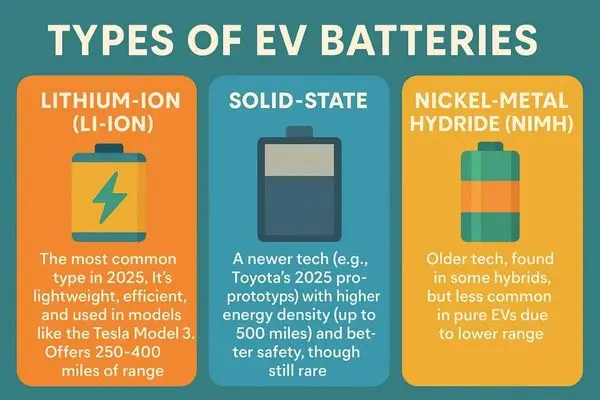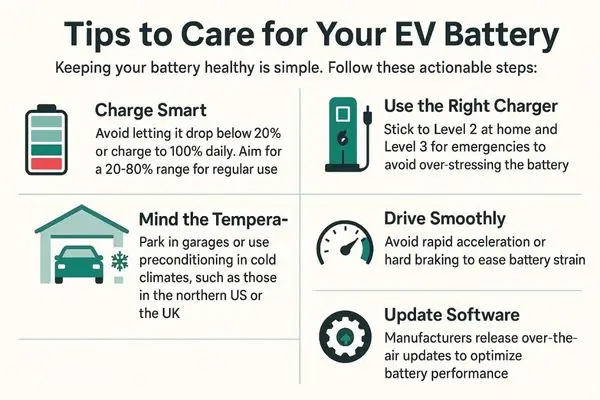Intro: Demystifying Your EV Battery
Welcome to hstech.io, your trusted source for tech insights!
Main Topics
Table of Contents
If you’re new to electric vehicles (EVs), the battery might seem like a mysterious powerhouse.
Questions like:
- How do I charge it?
- How long will it last?
Are common. Especially in 2025 as EV adoption grows across the USA, UK, and beyond. This beginner-friendly guide simplifies the technical side of EV batteries, covering types, charging options, lifespan, and easy care tips. By the end, you’ll feel confident managing your EV’s heart—no jargon, just clear facts! Let’s get started.
What Makes Up an EV Battery?
An EV battery is the core that powers your vehicle. Unlike gas tanks, it stores energy electrically. Here’s a simple guide about types of EV batteries:
Types of EV Batteries
- Lithium-Ion (Li-ion): The most common type of battery nowadays. It’s lightweight, efficient, and used in models like the Tesla Model 3. Lithium-Ion battery offers 250-400 miles of range.
- Solid-State: A newer tech (e.g., Toyota’s 2025 prototypes) with higher energy density (up to 500 miles) and better safety, though still rare.
- Nickel-Metal Hydride (NiMH): Older tech, found in some hybrids, but less common in pure EVs due to lower range.

Most EVs in the USA and Europe use Li-ion batteries because they balance cost, performance, and durability. Knowing your battery type helps you understand its needs.
See also: Electric Vehicles Demystified: The Ultimate easy Guide
Charging Your EV Battery: The Basics
Charging an EV isn’t as tricky as it seems. There are three main levels, each suited to different needs:
Level 1 Charging: Slow and Steady
- What It Is: Uses a standard 120-volt household outlet.
- Speed: Adds 2-5 miles of range per hour—great for overnight charging at home.
- Best for: Topping up daily or for those with short commutes (e.g., 20-30 miles in the UK or US suburbs).
Level 2 Charging: The Everyday Choice
- What It Is: Runs on a 240-volt outlet, common at homes or public spots like malls.
- Speed: Delivers 20-30 miles per hour, fully charging most EVs (250-300 miles) in 8-12 hours.
- Best for: Overnight home charging or workplace use, ideal for cities in the USA or European towns.
Level 3 Charging: Fast and Furious
- What It Is: DC fast chargers, found on highways and urban hubs.
- Speed: Boosts from 10% to 80% in 20-40 minutes (e.g., 150-200 miles), depending on the car.
- Best For: Road trips across the USA or long drives in Europe.
In 2025, with almost 150,000 public chargers in the USA and 50,000 in the UK, finding a spot is easier. Apps like PlugShare help locate them globally!
How Long Does an EV Battery Last?
Battery lifespan depends on use, care, and tech. Here’s what to expect:
- Mileage Lifespan: Most Li-ion batteries last between 100,000 and 200,000 miles. For example, a Tesla battery warranty covers 120,000 miles (8 years) in the USA.
- Calendar Lifespan: Typically 10-15 years, even with daily use. Solid-state batteries may stretch this to 20 years by 2030.
- Degradation: Batteries lose 1-2% of their capacity yearly, but modern thermal management (e.g., in the Nissan Leaf) keeps this loss minimal.
With proper care, your EV battery can outlast the car’s life, making it a solid investment!

Tips to Care for Your Battery
Keeping your battery healthy is simple. Follow these actionable steps:
- Charge Smart: Avoid letting it drop below 20% or charge to 100% daily. Aim for a 20-80% reduction in wear for regular use.
- Use the Right Charger: Stick to Level 2 at home and Level 3 for emergencies to avoid over-stressing the battery.
- Mind the Temperature: Park in garages or use preconditioning (pre-warming the battery) in cold climates, such as those in the northern US or the UK.
- Drive Smoothly: Avoid rapid acceleration or hard braking to ease battery strain.
- Update Software: Manufacturers like Ford release over-the-air updates to optimise battery performance.
These habits can extend your battery’s life by years, saving you money on replacements.
EV Battery Costs and Replacements
- Initial Cost: Built into the EV Price (e.g., $5,000-$15,000 of a $40,000 car).
- Replacement Cost: A new Li-ion battery typically ranges from $5,000 to $15,000, but it is rare to need a replacement before 10-15 years. Solid-state could drop to $3,000 by 2030.
- Warranty: Most cover 8 years/100,000 miles, so replacements are usually free if issues arise early.
With incentives and falling battery prices (down 80% since 2010), costs are less scary in 2025.
Benefits of Understanding Your EV Battery
- Confidence: Know when and how to charge, reducing anxiety.
- Savings: Extend battery life to avoid early replacements.
- Eco-Friendliness: Proper care maximises efficiency, cutting your carbon footprint.
Challenges to Watch Out For
- Cold Weather: The range can drop 10-20% in freezing conditions (e.g., Chicago winters), but technology is improving.
- Charging Access: Rural areas may lag in charger availability—plan ahead.
- Cost Perception: The high initial battery cost can deter buyers, although savings can offset this.
Future Trends for EV Batteries
- Longer Ranges: Solid-state batteries promise 500+ miles by late 2025.
- Faster Charging: 10-minute charging is currently in testing (e.g., Porsche Taycan).
- Recycling: A target of 95% battery material reuse is aimed for, enhancing sustainability.
The future looks bright for EV batteries globally!
Frequently Asked Questions (FAQs)
Q1: Can I Charge My EV at Home?
- A: Yes! A Level 1 charger works with any outlet, while a Level 2 (installed for $500-$1,500) is better for daily use.
Q2: How Often Should I Replace the Battery?
- A: Rarely—only if it drops below 70% capacity, typically after 10-15 years.
Q3: Does Fast Charging Hurt the Battery?
- A: Occasional use is acceptable, but daily fast charging can speed up degradation. Use Level 2 for routine.
Q4: Are EV Batteries Safe?
- A: Yes, with safety features like thermal management. Fires are less common in electric cars (according to NHTSA data).
Final Thoughts:
Your EV battery doesn’t have to be a mystery! With the right charging (Level 1, 2, or 3), care tips, and knowledge of its lifespan, you’re set for a smooth ride.
As EVs dominate roads in the USA, UK, and worldwide, understanding your battery’s capabilities boosts confidence and savings. Ready to dive deeper? Share your EV questions below or explore more at hstech.io!